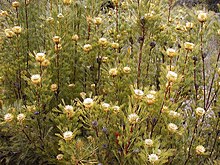en
names in breadcrumbs


Isopogon, commonly known as conesticks, conebushes or coneflowers,[3] is a genus of about forty species of flowering plants in the family Proteaceae, and are endemic to Australia. They are shrubs with rigid leaves, bisexual flowers in a dense spike or "cone" and the fruit is a small, hairy nut.
Plants in the genus Isopogon are erect or prostrate shrubs with rigid, usually compound, rarely simple leaves. Compound leaves are deeply divided with flat or cylindrical lobes. The flowers are usually arranged on the ends of branches, usually surrounded by bracts, in a more or less conical or spherical spike. Each flower is bisexual and symmetrical, the tepals spreading as the flower develops, the lower part persisting until the fruit expands. The fruit are fused to form a woody cone-like to more or less spherical structure, each fruit a nut with bracts that eventually fall and release the fruit. Isopogon have 13 haploid chromosomes.[3][4][5][6][7]
The genus Isopogon was first formally described in 1809 by Joseph Knight in On the cultivation of the plants belonging to the natural order of Proteeae, preempting publication of the same name by Robert Brown in his book On the natural order of plants called Proteaceae.[2][8]
The following is a list of species, subspecies and varieties of Isopogon accepted by the Australian Plant Census as at November 2020:[9]
Two new species of Isopogon, I. autumnalis (10 December 2019)[10][11] and I. nutans (5 May 2020)[12][13] have been described but the names have not been accepted by the Australian Plant Census as at November 2020.
 Isopogon anethifolius, Maranoa Gardens
Isopogon anethifolius, Maranoa Gardens Infructescence of Isopogon anemonifolius
Infructescence of Isopogon anemonifolius Isopogon, commonly known as conesticks, conebushes or coneflowers, is a genus of about forty species of flowering plants in the family Proteaceae, and are endemic to Australia. They are shrubs with rigid leaves, bisexual flowers in a dense spike or "cone" and the fruit is a small, hairy nut.
Isopogon es un género de arbustos de la familia Proteaceae. Se encuentra en Australia.[1]
Isopogon fue descrito por R.Br. ex Knight y publicado en On the cultivation of the plants belonging to the natural order of Proteeae 93. 1809.[2] La especie tipo es: Isopogon anemonifolius (R.A. Salisbury) Knight.
Isopogon es un género de arbustos de la familia Proteaceae. Se encuentra en Australia.
Isopogon est un genre d'arbustes de la famille des Protéacées endémiques dans toute l'Australie. Il en existe 35 espèces dans le genre, dont 27 poussent en Australie-Occidentale.
Ce sont des arbustes de petite taille ou des plantes rampantes.
Plusieurs espèces sont cultivées mais elles sont moins bien connues ou cultivés que les autres Proteaceae telles que les Banksia ou les Grevillea.
Selon NCBI (17 févr. 2011)[2] :
Isopogon est un genre d'arbustes de la famille des Protéacées endémiques dans toute l'Australie. Il en existe 35 espèces dans le genre, dont 27 poussent en Australie-Occidentale.
Ce sont des arbustes de petite taille ou des plantes rampantes.
Plusieurs espèces sont cultivées mais elles sont moins bien connues ou cultivés que les autres Proteaceae telles que les Banksia ou les Grevillea.
Isopogon R. Br. ex Knight – rodzaj roślin z rodziny srebrnikowatych (Proteaceae). Obejmuje co najmniej 2 gatunki[4] występujące endemicznie w Australii[5].
Według The Plant List oficjalnie potwierdzono istnienie 2 gatunków tego rodzaju. Jednak aż 68 taksonów posiada niepotwierdzony status gatunku[4].
Nazwa rodzajowa pochodzi z języka greckiego i oznacza równy („iso”) i broda („pogon”). Nazwa ta odnosi się do kępek włosów na wierzchołku okwiatu niektórych gatunków lub, być może, powołuję się na włosy mniej więcej równej długości pokrywające owoce tego rodzaju[4].
Rośnie naturalnie w Australii w stanach Australia Zachodnia, Australia Południowa, Queensland, Nowa Południowa Walia oraz Wiktoria[4].
Roślina dwupienna. Jest mezofityczna (przystosowana do klimatu umiarkowanie wilgotnego) lub kserofityczna. Kwiaty są zapylane przez owady[5].
Rodzaj z rodziny srebrnikowatych stanowiącej grupę siostrzaną dla platanowatych, wraz z którymi wchodzą w skład rzędu srebrnikowców, stanowiącego jedną ze starszych linii rozwojowych dwuliściennych właściwych[1]. W obrębie rodziny rodzaj stanowi klad bazalny w plemieniu Leucadendreae P.H. Weston & N.P. Barker, 2006. Plemię to klasyfikowane jest do podrodziny Proteoideae Eaton, 1836[6][7]
Isopogon R. Br. ex Knight – rodzaj roślin z rodziny srebrnikowatych (Proteaceae). Obejmuje co najmniej 2 gatunki występujące endemicznie w Australii.
Według The Plant List oficjalnie potwierdzono istnienie 2 gatunków tego rodzaju. Jednak aż 68 taksonów posiada niepotwierdzony status gatunku.
Isopogon é um género botânico pertencente à família Proteaceae[1].
Isopogon é um género botânico pertencente à família Proteaceae.
«Isopogon — World Flora Online». www.worldfloraonline.org. Consultado em 19 de agosto de 2020Trumpinnebusksläktet (Isopogon) är ett släkte med ungefär 30 arter i familjen proteaväxter. De är städsegröna buskar som ursprungligen kommer från Australien.
Blommorna sitter i runda samlingar. Blomfärgen är vit, ljusgul, rosa eller lila och blommorna doftar. Frukterna är förvedade och liknar tallkottar. Bladen är vanligen ljusgröna och flikiga. De är hårda och taggiga.
Isopogon-arterna vill ha väldränerad jord och en solig växtplats. De tål inte frost. Förökning sker med frön eller sticklingar.
Trumpinnebusksläktet (Isopogon) är ett släkte med ungefär 30 arter i familjen proteaväxter. De är städsegröna buskar som ursprungligen kommer från Australien.
Blommorna sitter i runda samlingar. Blomfärgen är vit, ljusgul, rosa eller lila och blommorna doftar. Frukterna är förvedade och liknar tallkottar. Bladen är vanligen ljusgröna och flikiga. De är hårda och taggiga.
Isopogon-arterna vill ha väldränerad jord och en solig växtplats. De tål inte frost. Förökning sker med frön eller sticklingar.
Изопогон (лат. Isopogon) — род растений семейства Протейные, эндемичный для Австралии, включающий в себя 35 видов многолетних кустарников. Наибольшее разнообразие видов приходится на запад материка.
Несколько видов культивируются как садовые растения.
По информации базы данных The Plant List, на август 2016 года род включает 2 действительных названия вида и 68 названий с неопределённым статусом[2].
Изопогон (лат. Isopogon) — род растений семейства Протейные, эндемичный для Австралии, включающий в себя 35 видов многолетних кустарников. Наибольшее разнообразие видов приходится на запад материка.
Несколько видов культивируются как садовые растения.